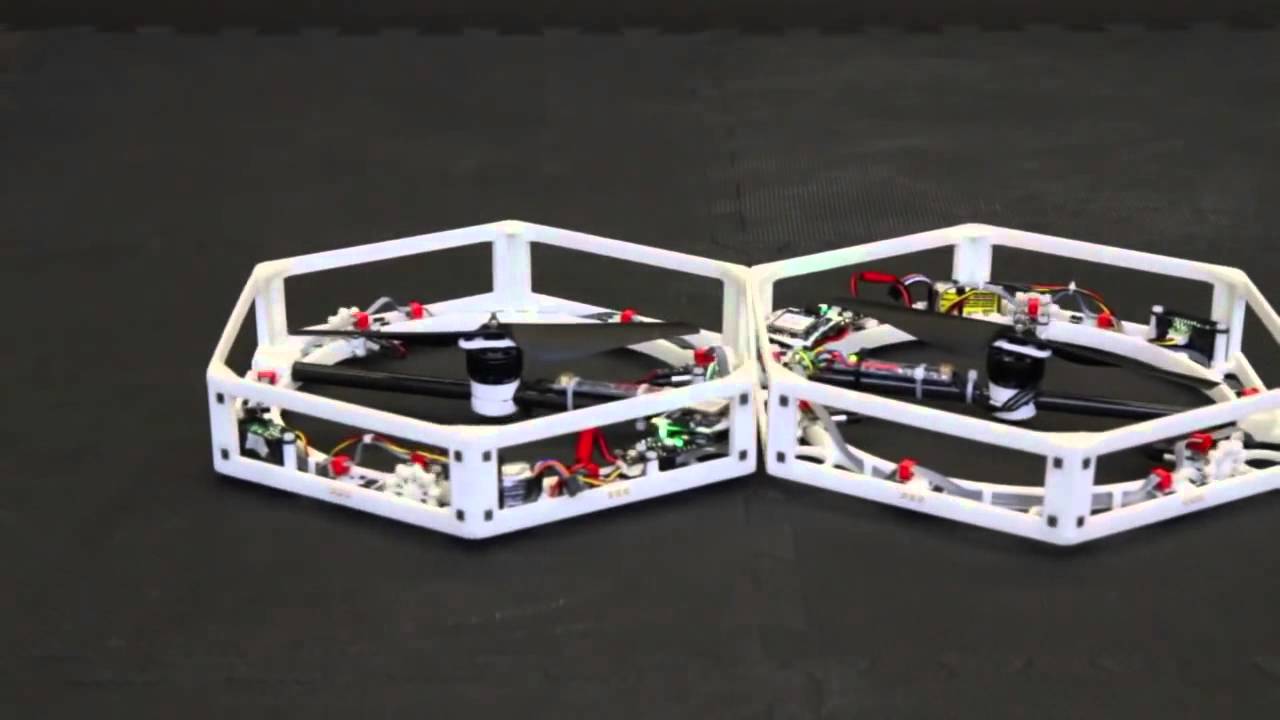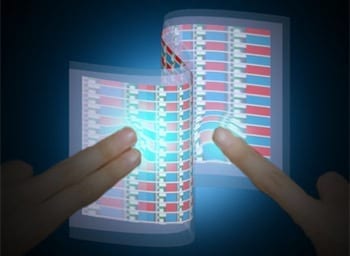
The wonky discipline known as “distributed computation algorithms” can be a bit … dry.
So instead of teaching the subject with problem sets and lengthy exams, the faculty of the Institute for Dynamic Systems and Control at ETH Zurich decided to educate students by having them develop a robotics platform that embodies the principles. The result, called the Distributed Flight Array (DFA), is a proto-Transformer that allows multiple autonomous robots to connect with each other and take flight while acting as an awesome platform for experimentation.
The DFA bots are small, but there is more than meets the eye packed into their 3-D printed chassis. The system is designed around a central propeller which provides thrust for the structure. Surrounding it are three omni-directional wheels that let the bots get into position with each other on the ground while magnets embedded in the frame provide a connection. A gyroscope provides positional information to an on-board microprocessor while an infrared sensor feeds information about altitude to the system. Pins allow the collected bots to communicate this real-time data between each other and adjust their individual thrusts to keep the combined unit stable. Despite the sensitive nature of the electronics, when a flight is over, the bots disengage midair and fall safely to the ground where the process can begin anew.
Individual units can only propel themselves spastically around a room, but when joined the DFA modules can create traditional quadcopters, more advanced decacopters, and their most impressive applications are atypical and asymmetrical arrays that defy traditional aeronautic aesthetics. These odd combos often produce interesting flight patterns — in one configuration where the bots are aligned linearly, the construct appears to flap as the opposite ends try to reach equilibrium.
The DFA was originally envisioned as an art installation and research platform by Professor Raffaello D’Andrea at ETH Zurich’s Institute for Dynamic Systems and Controls. Successive groups of students under the tutelage of Dr. Raymond Oung helped fulfill the vision, but also developed the project to the point where it was a versatile teaching tool. “The DFA is, and will always be, a pedagogical tool, both for high-end research and for the main-stream public,” says Oung. Academics will be able to use the distributed flight array as a low cost tool to test distributed algorithms — the kind of tools that might inform research on self driving cars or interoperability of machines on a factory floor. The relatively simple design of the DFA will also allow motivated science fair participants to crush their competition, like the Decepticon Devastator
The Latest Bing News on:
Autonomous Robots
- Arlington to use drones, delivery robots to deliver food to residents in needon May 8, 2024 at 2:40 pm
The City of Arlington is launching a program to use drones and robots to make deliveries to the city's most vulnerable citizens.
- Exclusive: Wayve co-founder Alex Kendall on the autonomous future for cars and robotson May 8, 2024 at 11:01 am
U.K.-based autonomous vehicle startup Wayve started life as a software platform loaded into a tiny electric "car" called Renault Twizy. Festooned with ...
- Mapping brain function, safer autonomous vehicles are focus of Schmidt Transformative Technology fundon May 8, 2024 at 8:58 am
This project aims to enhance the safety and reliability of autonomous vehicles and robots using processors known as neuromorphic photonic chips, which work in a manner analogous to neurons and perform ...
- US Marine Forces test autonomous rifle-fitted robot dogs, reports sayon May 8, 2024 at 6:32 am
A US publisher claims that MARSOC has employed two robotic dogs with firearm systems inspired by Onyx’s SENTRY Remote Weapon System (RWS) – one chambered in 7.62x39mm caliber and the other in 6.5mm ...
- Swarm of tiny snail robots stick together to form new structureson May 8, 2024 at 6:15 am
Researchers have built a swarm of miniature, snail-inspired robots, minus all the mucus. Instead, a retractable suction cup works in tandem with the remote-controlled machine’s tank-like treads to ...
- Asia-Pacific Agriculture Autonomous Robots Market Analysis 2023-2028 by Product, Application, and Country Featuring XMACHINES, BouMatic, and Tevelon May 8, 2024 at 1:28 am
Pacific Agriculture Autonomous Robots Market: Focus on Product, Application, and Country - Analysis and Forecast, 2023-2028" report has been added to ResearchAndMarkets.com's offering. The ...
- Wayve, an A.I. Start-Up for Autonomous Driving, Raises $1 Billionon May 6, 2024 at 4:01 pm
The London-based developer of artificial intelligence systems for self-driving vehicles raised the funding from SoftBank, Nvidia, Microsoft and others.
- Submission to the United Nations Secretary-General on Autonomous Weapons Systemson May 6, 2024 at 2:50 pm
Human Rights Watch appreciates the opportunity to submit its views and recommendations for consideration by the United Nations secretary-general in response to Resolution 78/241 on “Lethal autonomous ...
- Meet the new members of your jobsite safety team – robotson May 6, 2024 at 12:17 am
A pilot program using AI and autonomous robots provided detailed monitoring and scoring of everything from lighting conditions and fall hazards to PPE and fire safety, giving instant feedback to both ...
- Watch this autonomous excavator build a 215 foot retaining wall [video]on May 4, 2024 at 12:57 pm
Robotics experts at ETH Zurich have developed an excavator that uses advanced AI to complete high-skill tasks without a human operator.
The Latest Google Headlines on:
Autonomous Robots
[google_news title=”” keyword=”Autonomous Robots” num_posts=”10″ blurb_length=”0″ show_thumb=”left”]
The Latest Bing News on:
Self-assembling robots
- We got our hands on Dyson’s new robot vacuum, the 360 Vis Nav. Here’s our reviewon May 8, 2024 at 10:31 am
Its suction power and edge cleaning capabilities are impressive, but it lacks features like mopping and self-emptying that we'd expect ... the back of the docking base and shove the robot into its ...
- Tesla's Self-Driving Robotaxis May Get a China Rollout Firston May 8, 2024 at 8:43 am
A state-owned newspaper revealed that Elon Musk's moonshot Tesla vehicle may soon be self-driving through Chinese streets.
- Swarms of miniature robots clean up microplastics and microbes, simultaneouslyon May 8, 2024 at 8:14 am
When old food packaging, discarded children's toys and other mismanaged plastic waste break down into microplastics, they become even harder to clean up from oceans and waterways. These tiny bits of ...
- Comau presents its new S-Family of small, fast and element-resistant “hollow wrist” industrial robotson May 8, 2024 at 7:40 am
Comau debuts its new S-Family of small yet powerful robots at Automate 2024 in Chicago, Illinois. The first two high-speed robots, with payloads of 13 kg and up to 18 kg, are expressly indicated for ...
- Magnetic microrobot swarms clean water of microplastics and bacteriaon May 8, 2024 at 6:02 am
Microplastics are one of the biggest environmental and health risks faced by our generation. Now, researchers have developed swarms of tiny robots, or microrobots, that not only microplastics from ...
- Video shows how swarms of miniature robots simultaneously clean up microplastics and microbeson May 8, 2024 at 5:00 am
When old food packaging, discarded children's toys and other mismanaged plastic waste break down into microplastics, they become even harder to clean up from oceans and waterways. These tiny bits of ...
- These astonishing biobots can help neurons regrow — but researchers have no idea howon May 7, 2024 at 12:57 am
Scientists have created tiny, self-assembling robots made from human cells that could one day repair damaged skin and tissue. These tiny biological machines, called Anthrobots, are made from human ...
- Commentary: How robots making your burger and fries can lead to greater income inequalityon May 6, 2024 at 1:00 am
On April 1, more than half a million fast-food workers in California got a raise, with minimum wage across the sector bumped up to $20 per hour. That same week, ...
- Robotics, Sustainability, Resiliency Are Standards For Future Homeson May 3, 2024 at 6:01 am
Three startups demonstrate that technology and automation can be used to produce homes faster, at lower costs and with better performance.
- A Roundup of New Robotson May 1, 2024 at 6:16 am
The cups are available in four diameters, from 40 to 100 millimeters, and three mounting configurations (3/8G male or female and 32 millimeter square). All are made from thermoplastic polyurethane for ...
The Latest Google Headlines on:
Self-assembling robots
[google_news title=”” keyword=”self-assembling robots” num_posts=”10″ blurb_length=”0″ show_thumb=”left”]









